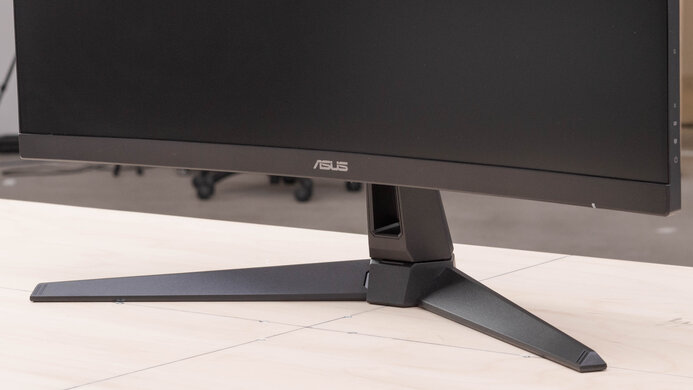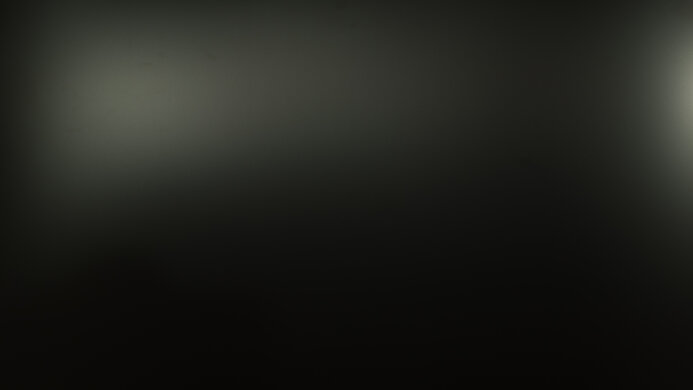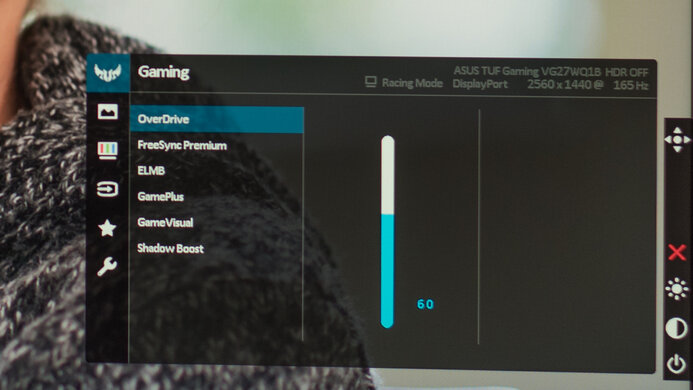The ASUS TUF Gaming VG27WQ1B is a great gaming monitor. It's packed with features most gamers should enjoy, like FreeSync variable refresh rate (VRR) support and G-SYNC compatibility. It also has an incredibly low input lag and a decent response time, but you may notice some motion blur with fast-moving content in dark scenes. Luckily, it has a Black Frame Insertion feature that helps improve the appearance of motion. It has a VA panel with a great contrast ratio, making it ideal for dark-room gaming, but it has narrow viewing angles and the image looks washed out when viewing from the sides. The ergonomics are also bad, so it may be difficult to place in an ideal viewing position. Lastly, it performs well in bright rooms thanks to its good reflection handling and high peak brightness.
Our Verdict
The ASUS TUF Gaming VG27WQ1B is good for mixed usage. It's a great gaming option thanks to its high refresh rate, low input lag, and VRR support. However, fast-moving content looks a bit blurry. It has a large screen and high resolution for office use or content creation, but it has narrow viewing angles and bad ergonomics. HDR content looks okay as it displays a wide color gamut, but it doesn't get bright enough to make highlights pop.
- Good reflection handling.
- Incredibly low input lag.
- Great contrast ratio.
- Bad ergonomics.
- Slow response time in dark scenes.
The ASUS TUF Gaming VG27WQ1B is decent for office use. The 27 inch, 1440p screen offers enough space for most people and has a high resolution so that you can easily open multiple windows. It also has good reflection handling and gets bright enough to combat glare. However, it has bad ergonomics and narrow viewing angles, making it harder to share your screen with others.
- Large screen and high resolution.
- Good reflection handling.
- Narrow viewing angles.
- Bad ergonomics.
The ASUS TUF Gaming VG27WQ1B is great for gaming. It has a high 165Hz refresh rate and VRR support to reduce screen tearing. The input lag is also incredibly low. The response time is only decent and you may notice some motion blur, but it has a Black Frame Insertion feature to help improve the appearance of motion. Lastly, it has a great contrast ratio for dark-room gaming.
- Incredibly low input lag.
- FreeSync support and G-SYNC compatibility.
- Great contrast ratio.
- Slow response time in dark scenes.
The ASUS TUF Gaming VG27WQ1B is decent for multimedia use. It has a large screen and a high resolution that help deliver crisp images. It also gets bright enough to combat glare and has good reflection handling. However, it has narrow viewing angles and the ergonomics are bad, so it's not ideal for sharing content with others. It displays deep blacks, but it has bad black uniformity that may become distracting.
- Large screen and high resolution.
- Good reflection handling.
- Narrow viewing angles.
- Bad ergonomics.
The ASUS TUF Gaming VG27WQ1B is decent for content creators. The 27 inch screen allows you to open multiple windows and the high resolution delivers crisp images. It performs well in bright and dark rooms thanks to its good peak brightness and high contrast ratio. Sadly, it has narrow viewing angles and limited ergonomics, so it may be hard to share your screen with a client.
- Large screen and high resolution.
- Good reflection handling.
- Narrow viewing angles.
- Bad ergonomics.
The ASUS TUF Gaming VG27WQ1B is okay for HDR gaming. It offers great gaming performance thanks to its 165Hz refresh rate, VRR support, and low input lag. However, you may notice some motion blur with fast-moving content because its response time is only decent. It displays a wide color gamut for HDR content, but it doesn't get bright enough to make highlights pop.
- Incredibly low input lag.
- Great contrast ratio.
- Displays wide color gamut.
- Slow response time in dark scenes.
- Low HDR peak brightness.
- No local dimming feature.
Changelog
- Updated Jul 14, 2021: We corrected an issue with the links in the Response Time @ 60Hz box.
- Updated Jan 20, 2021: For consistency, we've changed the height adjustment from N/A to 'No'. The score has been adjusted accordingly.
- Updated Dec 11, 2020: Review published.
- Updated Dec 08, 2020: Early access published.
Check Price
Differences Between Sizes And Variants
We tested the 27 inch ASUS TUF Gaming VG27WQ1B, which is the only size available for this product. However, there are other monitors in the TUF Gaming lineup, some of which are listed below.
| Model | Size | Resolution | Panel | Max Refresh Rate | Variable Refresh Rate | Notes |
| VG24VQR | 24" | 1080p | VA | 165Hz | FreeSync | Curved |
| VG27WQ1B | 27" | 1440p | VA | 165Hz | FreeSync | Curved |
| VG27VQ | 27" | 1080p | VA | 165Hz | FreeSync | Curved |
| VG27AQL1A | 27" | 1440p | IPS | 170Hz | Adaptive Sync | DisplayHDR 400 |
| VG27AQ | 27" | 1440p | IPS | 165Hz | FreeSync | |
| VG32VQ | 32" | 1440p | VA | 144Hz | FreeSync | Curved |
If someone comes across a different type of panel or if their ASUS VG27WQ1B doesn't correspond to our review, let us know and we will update the review. Note that some tests, such as the gray uniformity, may vary between individual units.
The VG27WQ1Bwe reviewed was manufactured in August 2020, and you can see the label here.
Popular Monitor Comparisons
The ASUS TUF Gaming VG27WQ1B is a great gaming monitor. It has a high contrast ratio that makes it suitable for dark-room gaming. However, its response time is only decent, and there's more motion blur than most 165Hz monitors we've tested. Although it's an inexpensive option, there are other similarly-priced monitors with a better response time, such as the Dell S3220DGF. See our recommendations for the best monitors for Xbox Series X, the best 1440p gaming monitors, and the best gaming monitors.
The ASUS TUF Gaming VG27AQL1A is better than the ASUS TUF Gaming VG27WQ1B, but they have different panel types. The VG27AQL1A has an IPS panel with wider viewing angles. It also has much better ergonomics, a quicker response time, and gets brighter in HDR. However, the VG27WQ1B has a VA panel with a better contrast, it displays clearer text, and it has much better out-of-the-box accuracy.
The ASUS TUF VG27AQ is better overall than the ASUS TUF Gaming VG27WQ1B, but they have different panel types. The VG27AQ has an IPS panel with wider viewing angles and it gets a bit brighter in HDR. It also has a much quicker response time at its max refresh rate, it has lower input lag and much better ergonomics. However, the VG27WQ1B has a VA panel with much better contrast, it has a quicker response time at 60Hz, and it displays a wide color gamut for HDR content.
The Gigabyte G27QC is slightly better than the ASUS TUF Gaming VG27WQ1B. The Gigabyte gets brighter, has a quicker response time at its max refresh rate and 60Hz, a lower input lag, and better ergonomics. However, the ASUS displays a wider SDR and HDR color gamut and has better out-of-the-box color accuracy, but this may vary between units.
The ASUS TUF Gaming VG27WQ1B is better overall than the ASUS TUF VG27VQ. The VG27WQ1B has a 1440p resolution against the VG27VQ's 1080p, it supports HDR, has a quicker response time, and better reflection handling. However, the VG27VQ has a slightly lower input lag and much better ergonomics.

We buy and test more than 30 monitors each year, with units that we buy completely on our own, without any cherry-picked units or samples. We put a lot into each unbiased, straight-to-the-point review, and there's a whole process from purchasing to publishing, involving multiple teams and people. We do more than just use the monitor for a week; we use specialized and custom tools to measure various aspects with objective data-based results. We also consider multiple factors before making any recommendations, including the monitor's cost, its performance against the competition, and whether or not it's easy to find.
Test Results

The ASUS TUF Gaming VG27WQ1B is a simple-looking monitor geared towards gamers, but it doesn't look out of place in an office environment, either. It has a slightly curved screen with thin borders on three sides and a thicker bottom bezel. It has the same V-shaped stand as the ASUS TUF Gaming VG27AQL1A, but the back looks a lot less premium.
Update 01/20/2021: For consistency, we've changed the height adjustment from N/A to 'No'. The score has been adjusted accordingly.
Sadly, the ASUS VG27WQ1B has bad ergonomics. Unlike the ASUS TUF Gaming VG27AQ1LA, it doesn't have any height adjustment. It also has a narrow swivel range, and you can't rotate it into portrait mode.
The back panel is basic plastic that feels solid. It's mainly matte throughout with a glossy strip near the inputs. Cable management is serviced through a hole in the stand.
The ASUS TUF Gaming VG27WQ1B's build quality is good. It's made mainly out of plastic and it feels solid. It has the same textured matte plastic throughout, except for some glossy plastic near the inputs. However, it seems like this glossy part comes from another model because the markings on it don't match up with the inputs. The stand supports the monitor well with almost no wobble, and the hinge doesn't feel like it would break. Overall, there's nothing fancy about this model, but it feels stable.
The contrast ratio is great, which is expected from a VA panel, and blacks look good. It's higher than the advertised 3000:1 contrast ratio, but this is something that may vary between units. Sadly, there's no local dimming feature to further improve the contrast.
The ASUS TUF Gaming VG27WQ1B doesn't have a local dimming feature. The video above is provided for reference only.
The ASUS VG27WQ1B has good SDR peak brightness. It maintains its brightness very consistently across different content, and it gets bright enough to combat glare in well-lit rooms. Also, it gets much brighter in real scenes than the advertised 250 cd/m².
We measured SDR peak brightness after calibration in the 'Racing' Picture Mode with RGB set to 'User'.
The ASUS VG27WQ1B has disappointing HDR peak brightness. Surprisingly, it gets less bright in HDR than in SDR, and it doesn't get bright enough to make highlights pop. We measured the HDR peak brightness in the 'ASUS Gaming HDR' Picture Mode.
The ASUS VG27WQ1B has a disappointing horizontal viewing angle, which is expected from a VA panel. The image looks inaccurate as you move off-center, so it's not ideal for sharing your screen with others. The edges may also look washed out if you sit really close, but the curved screen helps with this issue. If you want a similar monitor that has an IPS panel and wide viewing angles, look into the Gigabyte G27Q.
Once again, the vertical viewing angle is disappointing. You lose image accuracy if you mount it above eye level or if you sit too close.
The ASUS TUF Gaming VG27WQ1B's gray uniformity is outstanding, but this may vary between units. The corners are slightly darker, but it's hard to notice, and there's no dirty screen effect in the center. Uniformity is improved in near-dark scenes, but there's a bit of backlight bleed.
The ASUS VG27WQ1B's out-of-the-box accuracy is great. Some colors are inaccurate, but they're hard to notice. Color temperature is close to the 6500K target, but it's a bit on the cold side. Gamma doesn't follow the target curve all that well and most scenes are brighter than they should be. Note that out-of-the-box accuracy may vary between units.
The ASUS VG27WQ1B's accuracy after calibration is outstanding. Any remaining color and white balance inaccuracies can't be spotted by the human eye, and the color temperature is slightly closer to the target. Gamma does a better job at following the target curve, except some really bright scenes are still over-brightened.
You can download our ICC profile calibration here. This is provided for reference only and shouldn't be used, as the calibration values vary per individual unit even for the same model due to manufacturing tolerances.
The ASUS TUF Gaming VG27WQ1B has a good HDR color gamut. It's considered a wide color gamut with excellent coverage of the common DCI P3 color space. However, it has limited coverage of the wider Rec. 2020.
The DCI P3 coverage is much lower than the advertised 90% coverage. This is normal and is due to the way we measure DCI P3. We measure DCI P3 by sending a Rec. 2020 signal, but unlike most reviewers, we limit the colors we're sending to the DCI P3 primaries. This results in a lower, but arguably more accurate measurement.
The ASUS VG27WQ1B has good text clarity. It's a bit better than most 27 inch, 1440p monitors we've tested such as the ASUS TUF Gaming VG27AQL1A. Enabling ClearType (top photo) helps improve the appearance of diagonal lines, but some straight lines aren't as bold.
| Overdrive Setting | Response Time Chart | Response Time Tables | Motion Blur Photo |
| 0 | Chart | Table | Photo |
| 20 | Chart | Table | Photo |
| 40 | Chart | Table | Photo |
| 60 | Chart | Table | Photo |
| 80 | Chart | Table | Photo |
| 100 | Chart | Table | Photo |
The ASUS TUF Gaming VG27WQ1B has a decent response time at its max refresh rate of 165Hz. The recommended overdrive setting is '100' because it has the quickest response time, but there's noticeable overshoot in some transitions. There's also visible blur trail and smearing with fast-moving objects in dark scenes, which could be distracting.
| Overdrive Setting | Response Time Chart | Response Time Tables | Motion Blur Photo |
| 0 | Chart | Table | Photo |
| 20 | Chart | Table | Photo |
| 40 | Chart | Table | Photo |
| 60 | Chart | Table | Photo |
| 80 | Chart | Table | Photo |
| 100 | Chart | Table | Photo |
Update 07/14/2021: We updated the links in the above table, as they were incorrectly linking to the max refresh rate results.
The response time at 60Hz is good. There's less blur trail than at its max refresh rate, but the response time is slow in dark transitions, so there's still a bit of smearing. The recommended overdrive setting is '60' as there's minimal overshoot in most transitions, so you may have to change the setting if your game's frame rate drops.
The ASUS TUF Gaming VG27WQ1B has a Black Frame Insertion feature to help improve the appearance of motion, but it has a somewhat narrow flicker range. It can't be used with VRR enabled, and we experienced some issues when trying to enable BFI after disabling VRR. When we disabled VRR in the on-screen menu, it didn't disable G-SYNC in the NVIDIA Control Panel. After, we tried to enable BFI and it wasn't working properly because G-SYNC was still enabled. You have to first disable G-SYNC in the NVIDIA Control Panel, disable VRR in the monitor's settings, then enable BFI for it to work properly.
The ASUS TUF Gaming VG27WQ1B has an outstanding refresh rate. G-SYNC only works over DisplayPort, and the refresh rate is capped at 144Hz over HDMI.
The ASUS VG27WQ1B has an incredibly low input lag, and it remains low with VRR enabled, which is great. We didn't measure the 10-bit HDR input lag because you can only achieve its 165Hz refresh rate with a 10-bit signal over a DisplayPort connection, and we don't have the tools necessary to measure input lag with HDR over DisplayPort. The max 10-bit refresh rate over HDMI is 60Hz. That said, we don't expect the 10-bit HDR input lag to increase significantly from its native resolution.
This monitor has a great resolution and size. There's enough space to open multiple windows side-by-side, and the 1440p resolution helps deliver crisp images.
The markings on the glossy plastic above the inputs don't seem to line up with the actual inputs. The DisplayPort input is labeled as VGA, and it doesn't have a VGA input. Also, there's a symbol for an Audio Line Out, when there is none. If you have this monitor and notice the same issue, let us know.
The ASUS VG27WQ1B has a few extra features, which are listed below:
- Shadow Boost: Brightens the shadows in dark areas, making it easier to see your opponents.
- GamePlus
- Crosshair: Adds a virtual crosshair on the screen for FPS games.
- FPS Counter: Displays the current frames per second.
- Timer: Adds a timer on the screen.
- Display Alignment: Adds a grid to make it easier to set up in a multi-monitor configuration.
- Low Blue Light: Removes blue light, which helps reduce eye strain.



















































